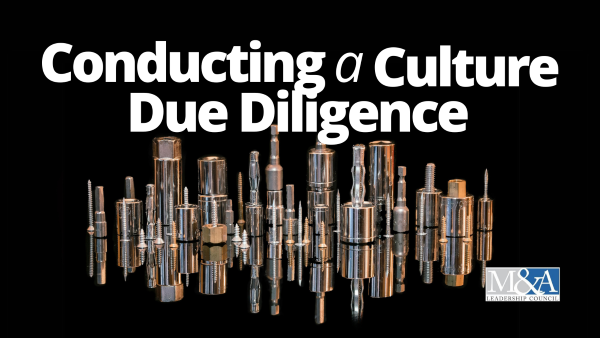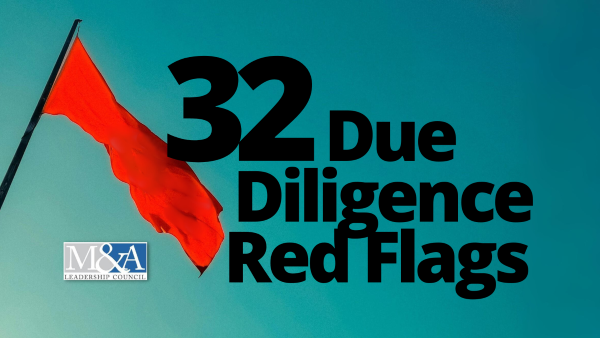Conducting a Culture Due Diligence
Some Actual What-to-Do’s
By M&A Leadership Council
Everyone probably knows that financial, legal, and operational aspects of a business typically receive the most attention during due diligence.
However, one equally important but often overlooked element is culture due diligence.
Understanding and assessing the culture of the target company is crucial for the long-term success of the acquisition, as this helps identify potential cultural clashes and integration challenges.
Here are some actual what-to-do’s for conducting culture due diligence:
1. Preparation
- Define Objectives: Clarify what you want to achieve through cultural due diligence, such as identifying cultural differences, assessing compatibility, and understanding integration risks.
- Assemble a Team: Form a team with HR professionals, cultural experts, and representatives from both companies.
- Set Clear Metrics: Determine how you will measure cultural alignment and success, such as employee satisfaction scores, retention rates, and productivity levels.
- Develop a Timeline: Create a detailed timeline for the cultural due diligence process, including milestones and deadlines.
- Stakeholder Engagement: Identify key stakeholders in both organizations who will provide valuable insights and support for the cultural due diligence process.
- Resource Allocation: Allocate necessary resources, including budget, tools, and personnel, to ensure the process is thorough and effective.
2. Data Collection
- Surveys and Questionnaires: Develop and distribute surveys to employees at all levels to gather information on values, behaviors, and attitudes.
- Interviews: Conduct interviews with key stakeholders, including executives, managers, and employees, to gain deeper insights into the company culture.
- Document Review: Analyze company policies, handbooks, internal communications, and other relevant documents to understand formal and informal cultural norms.
- Customized Surveys: Tailor surveys to specific departments or roles to capture nuanced cultural differences and similarities.
- Focus Groups: Conduct focus groups with employees from different levels and departments to gather qualitative data.
- Observation: Observe day-to-day operations and interactions to gain a real-time understanding of the cultural environment.
- Cultural Artifacts: Collect and analyze cultural artifacts such as company logos, office layouts, and dress codes that reflect the organization’s culture.
3. Analysis
- Cultural Assessment Tools: Use tools like the Cultural Values Assessment (CVA) or Organizational Culture Assessment Instrument (OCAI) to systematically assess cultural attributes.
- Identify Key Cultural Dimensions: Focus on dimensions such as leadership styles, decision-making processes, communication styles, employee engagement, and work-life balance.
- Cultural Mapping: Create a cultural map that highlights similarities and differences between the merging companies.
- Benchmarking: Compare the cultural attributes of the merging companies against industry benchmarks to identify unique cultural strengths and weaknesses.
- Gap Analysis: Perform a gap analysis to highlight areas where the cultures diverge significantly and may cause integration challenges.
- SWOT Analysis: Conduct a SWOT analysis (Strengths, Weaknesses, Opportunities, Threats) focused specifically on cultural aspects.
- Heat Maps: Create heat maps to visually represent areas of cultural alignment and misalignment.
4. Evaluation
- Compatibility Assessment: Determine the degree of cultural compatibility between the two organizations. Identify areas of potential synergy and conflict.
- Impact Analysis: Assess the potential impact of cultural differences on integration efforts, employee morale, and overall business performance.
- Scenario Planning: Develop scenarios to anticipate how cultural differences might manifest during integration and plan mitigation strategies.
- Risk Assessment: Evaluate the risks associated with cultural integration and develop risk mitigation plans.
- Sensitivity Analysis: Conduct sensitivity analysis to understand how sensitive the integration process is to different cultural factors.
- Cultural Champions: Identify cultural champions within both organizations who can help facilitate cultural alignment and integration.
5. Reporting
- Findings Report: Prepare a detailed report summarizing the findings, including key cultural similarities and differences, potential integration challenges, and recommendations.
- Executive Summary: Provide an executive summary for senior leadership, highlighting critical insights and strategic recommendations.
- Detailed Findings: Provide a detailed breakdown of findings for each cultural dimension assessed, including quantitative and qualitative data.
- Visual Aids: Use charts, graphs, and other visual aids to clearly communicate cultural similarities and differences.
- Actionable Recommendations: Offer specific, actionable recommendations for addressing cultural gaps and leveraging cultural strengths.
- Stakeholder-Specific Reports: Tailor reports for different stakeholders, such as executives, HR, and line managers, highlighting the information most relevant to them.
6. Integration Planning
- Cultural Integration Strategy: Develop a strategy to address cultural integration, including initiatives to align cultures, bridge gaps, and promote a unified organizational culture.
- Communication Plan: Create a communication plan to transparently convey the cultural integration process to all employees.
- Monitor and Adjust: Continuously monitor the cultural integration process and make adjustments as needed to ensure successful integration.
- Integration Roadmap: Develop a detailed roadmap for cultural integration, outlining specific actions, timelines, and responsible parties.
- Integration Workshops: Plan and conduct workshops to align leaders and employees on the cultural integration strategy.
- Alignment Initiatives: Design and implement initiatives to align values, such as joint team-building activities and cross-functional projects.
- Cultural Ambassadors: Establish a network of cultural ambassadors to promote and support cultural integration efforts across the organization.
7. Implementation
- Leadership Alignment: Ensure leaders from both organizations are aligned and committed to the cultural integration process.
- Employee Involvement: Involve employees in the integration process through workshops, focus groups, and feedback sessions.
- Training and Development: Provide training programs to help employees understand and adapt to cultural changes.
- Ongoing Training: Provide ongoing training and development programs to support employees in adapting to cultural changes.
- Feedback Mechanisms: Establish mechanisms for continuous feedback from employees on the cultural integration process.
- Cultural Metrics Tracking: Continuously track and measure cultural metrics to assess the effectiveness of integration efforts.
- Celebrate Successes: Recognize and celebrate cultural integration milestones and successes to reinforce positive cultural changes.
Best Practices
- Early Start: Begin cultural due diligence early in the M&A process to identify and address issues proactively.
- Focus on Core Values: Identify and preserve core values that are critical to the success of both organizations.
- Foster Open Communication: Encourage open and transparent communication to build trust and address concerns.
- Cultural Due Diligence Templates: Use or develop templates and checklists to standardize the cultural due diligence process.
- Peer Learning: Learn from other organizations’ experiences with cultural integration in M&A to apply best practices and avoid common pitfalls.
- Third-Party Consultants: Consider engaging third-party cultural consultants to provide an unbiased perspective and expert guidance.
- Post-Integration Reviews: Conduct post-integration reviews to evaluate the success of the cultural integration and identify areas for continuous improvement.
Conducting thorough cultural due diligence can significantly enhance the chances of a successful merger or acquisition by ensuring cultural alignment and minimizing integration risks.
—————————————————————
FAQ:
1. Why is cultural due diligence important in mergers and acquisitions?
Answer: Cultural due diligence is crucial because it helps identify potential cultural clashes and integration challenges that could undermine the success of a merger or acquisition. By understanding the cultural differences and similarities between the merging organizations, companies can develop strategies to align cultures, foster collaboration, and minimize integration risks, ultimately improving the chances of a successful merger or acquisition.
2. What tools and methods can be used to assess organizational culture?
Answer: Several tools and methods can be used to assess organizational culture, including:
- Surveys and Questionnaires: Tailored to capture employee values, behaviors, and attitudes.
- Interviews: Conducted with key stakeholders to gain deeper insights.
- Cultural Assessment Tools: Such as the Cultural Values Assessment (CVA) or Organizational Culture Assessment Instrument (OCAI).
- Focus Groups: To gather qualitative data from employees.
- Observation: To understand the cultural environment in real-time.
- Document Review: Analyzing company policies, handbooks, and internal communications.
3. How can companies ensure effective cultural integration post-merger?
Answer: Companies can ensure effective cultural integration by:
- Developing a Cultural Integration Strategy: Including initiatives to align cultures and bridge gaps.
- Creating a Communication Plan: To transparently convey the integration process to all employees.
- Involving Employees: Through workshops, focus groups, and feedback sessions.
- Providing Ongoing Training: To help employees adapt to cultural changes.
- Monitoring and Adjusting: Continuously tracking cultural metrics and making necessary adjustments to the integration plan.
4. What are some common challenges faced during cultural due diligence?
Answer: Common challenges during cultural due diligence include:
- Resistance to Change: Employees may be resistant to changes in culture.
- Identifying Subcultures: Different departments or teams may have distinct subcultures that complicate the integration process.
- Bias and Subjectivity: Cultural assessments can be influenced by biases and subjective views.
- Communication Barriers: Differences in communication styles can hinder the collection and interpretation of cultural data.
- Resource Constraints: Limited time, budget, and personnel can affect the thoroughness of the cultural due diligence process.
5. What are the key indicators of cultural compatibility between merging companies?
Answer: Key indicators of cultural compatibility include:
- Shared Values and Beliefs: Alignment in core values and organizational beliefs.
- Leadership Styles: Similar approaches to leadership and decision-making.
- Communication Styles: Compatibility in how information is communicated and shared.
- Employee Engagement: Similar levels of employee engagement and morale.
- Work-Life Balance: Comparable attitudes towards work-life balance and employee well-being.
- Cultural Artifacts: Consistency in cultural symbols, rituals, and practices.






